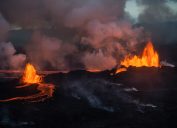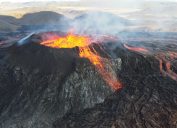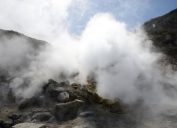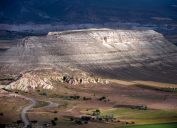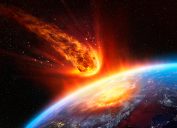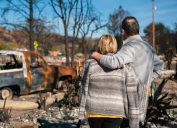Why Latest Iceland Volcano Eruption Is a "Worst Case Scenario," Expert Says
Homes in Grindavik are ablaze and residents fear their town "might be over."

Less than a month after a volcano erupted on Grindavik, the charming southwestern Icelandic town is facing yet another harrowing natural disaster. The warning signs were similar—a multitude of small yet sizable earthquakes that were met with gallons of hot lava rocketing into the sky, followed by enormous clouds of black smoke. Having lived through this exact moment just weeks prior, the community of Grindavik was already on edge when the volcano erupted for the second time on Sunday.
RELATED: One of America's "Very High Threat" Volcanoes Keeps Quaking—Could It Erupt Any Day Now?
Local newspapers are dubbing Jan. 14 a "black day" for Iceland. According to Time, an estimated 3,800 citizens were evacuated after the island began shaking. Earthquakes that happen where volcanoes are present—and especially active—are typically considered a precursor to an eruption. By early Sunday morning, Grindavik was nearly swimming in a sea of molten lava.
The Icelandic Meteorological Office said that things began to escalate when an 1,476-foot crack in the ground grew into a 2,953-foot fissure within hours. Molten lava spewed out of the fissure, engulfing neighboring homes. Another fissure measuring 328 feet erupted at noon. Both fissures remain active, but the amount of extracting lava has decreased, per the office's website.
Thankfully, no casualties have been reported and other areas of the island have been deemed safe by Iceland's Civil Protection service, per the BBC. Flights are still coming in and out of Keflavik International Airport as normal despite the smoky air. However, the roads coming into Grindavik are closed, as is the nearby spa and destination hot spot, Blue Lagoon.
As for when Grindavik residents will be able to return home, that remains to be seen. Many homes and businesses have been destroyed by the magma, and those still standing no longer have running hot water or general heat due to pipe damage.
"We have been told that there are cracks all over the place," Sunna Jonina Siguroardottir, who lives in Grindavik, said during a radio broadcast, per the BBC. She added that while the town may look like it's recovering on the surface, much of the damage may take years to even uncover.
"[The cracks] are deep in the ground and the effects are not necessarily visible on the surface until after a few years. At any time, something can give way and open up," she explained.
Another local said Grindavik "might be over" for good, and residents may need to "start all over, somewhere else."
RELATED: Italian Supervolcano Is Sparking Concern and Evacuation Plans.
Once Grindavik does open back up to civilians, science journalist and volcanologist Robin Andrews points out that the town may not be liveable for a number of reasons. In response to the amount of lava that's infiltrated Grindavik, Andrews told the BBC, it's "pretty much a worst case scenario."
Aside from the burned homes, the air quality could potentially be "fairly problematic" for people who are immunocompromised or have pre-existing breathing problems.
The outlet notes that a volcanic eruption releases sulfur dioxide, which is "a noxious gas that is an irritant to the skin, eyes, nose and throat."
"What can be said with certainty is that it's an extremely perilous and deleterious situation," Andrews added.
So while conditions have improved, it's not yet clear when—if ever—Grindavik will return to some sort of normalcy.
RELATED: For more up-to-date information, sign up for our daily newsletter.
